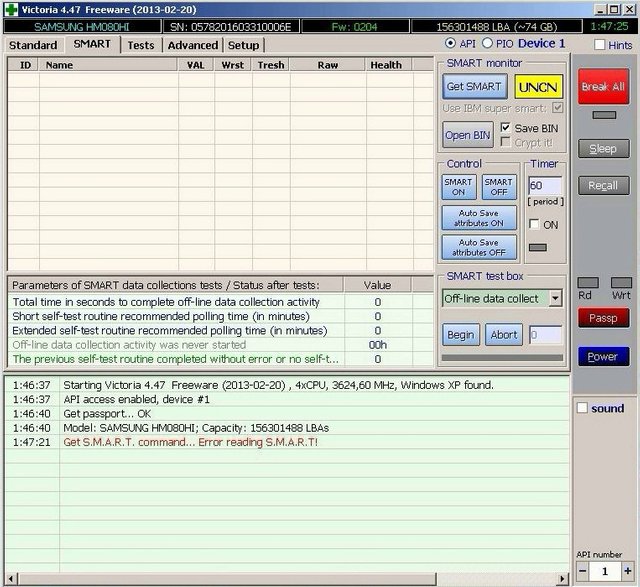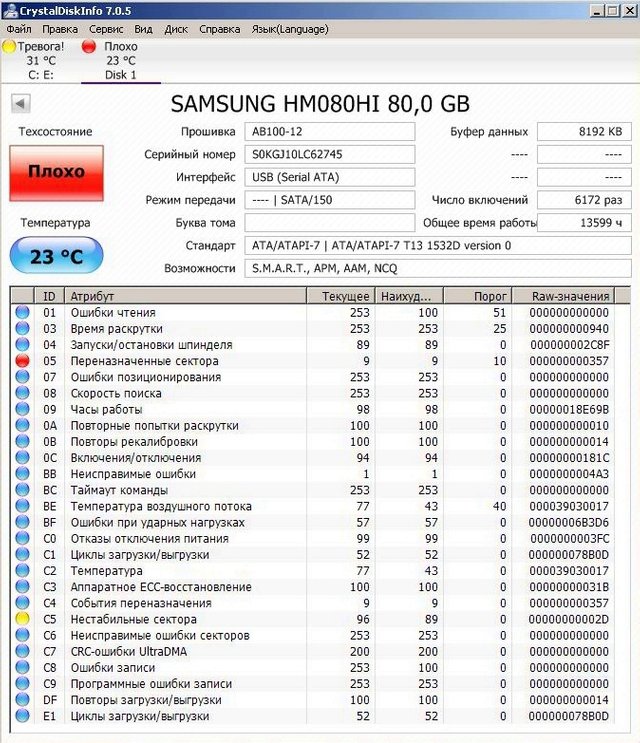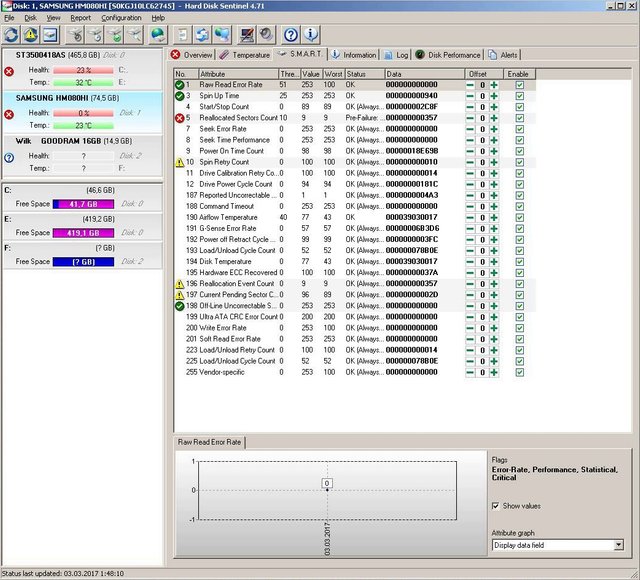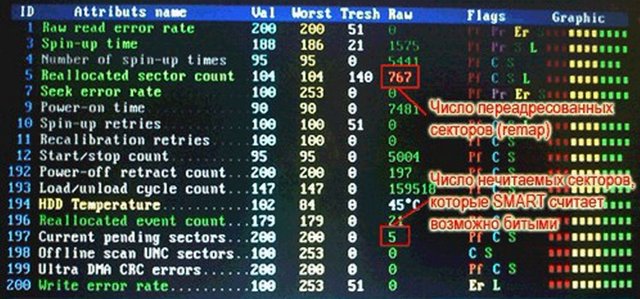S. M. A. R. T. (from the English. self-monitoring, analysis and reporting technology self-monitoring, analysis and reporting) technology assessment of the state of the hard disk drive built-in hardware self-diagnosis, as well as the mechanism of a prediction of time of failure.
Simply put - a collection of various hard disk parameters and wow account and forecast wear on these parameters. Why you need smart to you personally? Well, if it's your personal PC then you can quickly save your information and not lose it in case of failure of hard drive, better certainly important information to keep and without any SMARTS, but we are all as usual).
Suppose you want to buy a hard drive with it, seeing S. M. A. R. T. you can easily determine how much it is in principle suitable for you. The full surface test, which is usually very long and maybe not with his hands, again, many defects can hide, but not to hide from S. M. A. R. T.
Yes S. M. A. R. T. can reset to zero, but such manipulations are only available on fairly expensive equipment(PC-3000) and ordinary private traders or stores it there.
Hard drives Seagate S. M. A. R. T. resets the most simple and practical in the home, if desired, so that the manufacturer be more careful.
S. M. A. R. T. can be considered a variety of programs that usually use Victoria for Windows. Sometimes Victoria can give you on request data S. M. A. R. T., the answer is: get S. M. A. R. T. command Error reading S. M. A. R. T! and the status of the UNCN

Many people associate the UNCN status with S. M. A. R. T. BAD, what is wrong. UNCN means that smart failed to read in principle. It is believed that Victoria does not support the new hard disks and correspondingly their S. M. A. R. T. is another error, for example when you request a smarta on an old hard disk drive Samsung HM080HI you get the same UNCN and this hard drive is no exception.
What to do in this case? You can read S. M. A. R. T. another program which a great many. In principle, the most convenient user option is Crystal Disk Info, in fact the purpose of this program is to read the S. M. A. R. T. with this task, this program excels. Crystal Disk Info shows immediately and options S. M. A. R. T. status and the Good Anxiety and Bad

Anxiety is usually within the acceptable range, but the Bad status clearly indicates excessive wear of the hard disk. At the same time more professional and, in principle, accessible program that is Hard Disk Sentinel among hundreds of hard drives but have never had a failure with this program a great advantage, is what Hard Disk Sentinel takes the data S. M. A. R. T. and immediately converts into a percentage of life that for the user and for beginners is very convenient.

In fact, no matter what program you have S. M. A. R. T. You need to pay attention to two values, which will show you the number of bad sectors, as well as the supposedly bad sectors
Reallocated sector count - the Number of forwarded sectors(Remap)
Current pending sectors - the Number of unreadable sectors that S. M. A. R. T. believes it is possible beaten.
Are also important parameters: the Power-On Hours (ID=0х9, the number of hours spent in the on state) or a Device Power Cycle Count (ID=0x0C, the number of complete cycles of on-off drive).
And not fall whether the drive in the process? (I mean physically, on the floor) attribute G-sense error rate (0хBF, the number of errors resulting from shock loads)

Not all hard drives the same parameters the same. Among the hard drives of many models that have defects in the firmware that manufacturers very rarely advertise edits and produces these errors. S. M. A. R. T. cannot be considered as universal tool for determination of a hard drive failure. But for the initial diagnosis S. M. A. R. T. at the time.
Decoding options. The source
Raw Read Error Rate - Frequency of errors while reading data from the disk. This parameter shows frequency of appearance of errors at read operations from a disk surface through the fault of the hardware drive.
Spin Up Time - the Time of promotion of a spindle. The average time of promotion of a spindle of the disk from 0 RPM to operating speed. Presumably, in the raw value contains the time in milliseconds/seconds.
Reallocated Sector Count - number of remapped sectors. When the hard drive encounters a read error/write/verification it tries to move data from it into a special reserve area (spare area) and, if successful, marks the sector as
Start/Stop Count amount of cycles start/stop the spindle. The raw value stores the total number of on/off cycles of the disk.
Read Channel Margin reserve of channel while reading data. The purpose of this attribute is not documented in modern drives is not used.
Seek Error Rate frequency of appearance of errors of positioning BMG. In the event of a failure in the mechanical system of positioning, damage servomotor (servo), strong thermal extension of disks, etc. arise positioning errors. The more, the worse mechanics and/or the surface of the hard disk.
Seek Time Performance - the average performance positioning BMG. This option shows the average speed of the positioning drive of BMG on a specified sector. The decrease in the value of this attribute indicates a malfunction in the mechanics of the drive.
Power-On Hours - the number of hours worked in the on state. The raw value of this attribute shows the number of hours (minutes, or seconds, depending on manufacturer), worked hard drive. The decrease in the value (value) attribute to a critical level (threshold) indicates the production of a disk resource (MTBF - Mean Time Between Failures). In practice, even the fall of this attribute to zero may not always indicate a real depletion of the resource and the drive can continue to function normally.
Spin Retry Count - number of repetitions of attempts of start of a spindle drive. This attribute records the total number of attempts of promotion of a spindle and its output at working speed, provided that the first attempt was unsuccessful. The decrease in the value of this attribute indicates a malfunction in the mechanics of the drive.
Recalibration Retries - number of retries recalibrate the drive. This attribute records the total number of attempts reset drive and install the heads on track zero, provided that the first attempt was unsuccessful. The decrease in the value of this attribute indicates a malfunction in the mechanics of the drive.
Device Power Cycle Count - the number of complete cycles start/stop the hard drive.
Soft Read Error Rate - frequency of occurrence
Reported UNC Errors - errors that could not be recovered using methods to troubleshoot the error hardware.
Load/Unload cycle count - the number of cycles of the output of BMG in a special Parking zone/into position. For more details, see the description of technology Head Load/Unload Technology.
Drive Temperature temperature. This parameter displays in the raw value indication of the built-in temperature sensor in degrees Celsius.
Reallocation Event Count - the number of the reassignment (remapping). The raw value of this attribute shows the total number of attempts to remap bad sectors to a spare area taken by the drive. At the same time, taking into account both successful and unsuccessful operations.
Current Pending Sector Count - current number of unstable sectors. The raw value of this attribute shows the total number of sectors that the drive currently considers applicants for reassignment to a spare area (remap). If in the future some of these sectors are read successfully, then it is excluded from the list of applicants. If the read sector is accompanied by an error, the drive will attempt to recover the data and transfer them to the spare area, and the sector is marked as remapped (remapped). Constantly nonzero raw value of this attribute indicates a low quality (separate zones) of the disk surface.
Reported UNC Errors - errors that could not be recovered using methods to troubleshoot the error hardware.
Load/Unload cycle count - the number of cycles of the output of BMG in a special Parking zone/into position. For more details, see the description of technology Head Load/Unload Technology.
Drive Temperature temperature. This parameter displays in the raw value indication of the built-in temperature sensor in degrees Celsius.
Reallocation Event Count - the number of the reassignment (remapping). The raw value of this attribute shows the total number of attempts to remap bad sectors to a spare area taken by the drive. At the same time, taking into account both successful and unsuccessful operations.
Current Pending Sector Count - current number of unstable sectors. The raw value of this attribute shows the total number of sectors that the drive currently considers applicants for reassignment to a spare area (remap). If in the future some of these sectors are read successfully, then it is excluded from the list of applicants. If the read sector is accompanied by an error, the drive will attempt to recover the data and transfer them to the spare area, and the sector is marked as remapped (remapped). Constantly nonzero raw value of this attribute indicates a low quality (separate zones) of the disk surface.
Uncorrectable Sector Count - the number of uncorrected errors. The attribute shows the total number of errors that occurred when reading/writing a sector and that failed to adjust. Growth values in the raw value of this attribute points to an obvious surface defects and/or problems in the mechanics of the drive.
UltraDMA CRC Error Count - total number of errors CRC in mode UltraDMA. The raw value contains the number of errors in the data transfer mode UltraDMA in checksum (ICRC - Interface CRC). Author's note. Practice, the assembled statistics and learning of error logs SMART show: in most cases errors CRC arise at the strong overestimate of frequency PCI (more nominal 33.6 MHz), strongly twisted cable, and also - at fault drivers who do not comply with requirements transmission/data reception in modes UltraDMA.
Write Error Rate (Multi Zone Error Rate) - the frequency of occurrence of errors when writing data. Shows the total number of errors detected during the recording sector. The higher the value in the raw value (or lower value), the worse the condition of the disc surface and/or the mechanics of the drive.
Disk Shift - Shift the disc relative to the axis of the spindle. The actual value of the attribute contains in the raw value. Units of measurement are not known. Details - see the description of the technology G-Force Protection. Note. The shift disc are possible as a result of strong shock loading on the drive as a result of his fall or for other reasons.
G-Sense Error Rate - frequency of errors resulting from shock loads. This attribute stores readings udrocortisone sensor - the total number of errors in the result storage external shock (falling, improper installation, etc.). For more details, see the description of technology G-Force Protection.
Loaded Hours - the load on the drive BMG caused by a common operating hour drive. Takes into account only the period during which the heads were in working position.
Load/Unload Retry Count load on the drive BMG caused by a number of repeated operations of reading, recording, positioning of heads, etc. is taken into account only the period during which the heads were in working position.
Load Friction load on the drive BMG caused by friction in mechanical parts of the drive. Takes into account only the period during which the heads were in working position.
Load/Unload Cycle Count is the total number of cycles of load on the drive BMG. Takes into account only the period during which the heads were in working position.
Load-in Time total time load on the drive BMG. Presumably, this attribute indicates the total time of operation of the drive under load, provided that the heads are in working condition (outside Parking area).
Torque Amplification Count - the amount of effort drive torque.
Power-Off Retract Count - the number of fixed iterations(s)preparation food storage.
GMR Head Amplitude - amplitude of shake GMR-heads (GMR-Head) in working condition.
Hello & Cheers!! I'm a content detection and information bot. You are receiving this reply because a short link or links have been detected in your post/comment. The purpose of this message is to inform your readers and yourself about the use of and dangers of short links.
To the readers of the post: Short links are provided by url shortening services. The short links they provide can be useful in some cases. Generally their use is benign. But as with all useful tools there are dangers. Short links can be used to hide all sorts of things. Quite frequently they are used to hide referral links for instance. While not dangerous this can be deceptive. They can also be used to hide dangerous links such as links to phishing sites, sites loaded with malware, scam sites, etc. You should always be extremely cautious before clicking on one. If you don't know and trust the poster don't click. Even if you do you should still be cautious and wary of any site you are sent to. It's always better to visit the site directly and not through a short link.
To the author of the post: While short links may be useful on some sites they are not needed on steemit. You can use markdown to format your links such as this link to steemit. It's as simple as
[steemit](https://steemit.com)Unlike short links this allows the reader to see where they are going by simply hovering over the link before they click on it.Downvoting a post can decrease pending rewards and make it less visible. Common reasons:
Submit